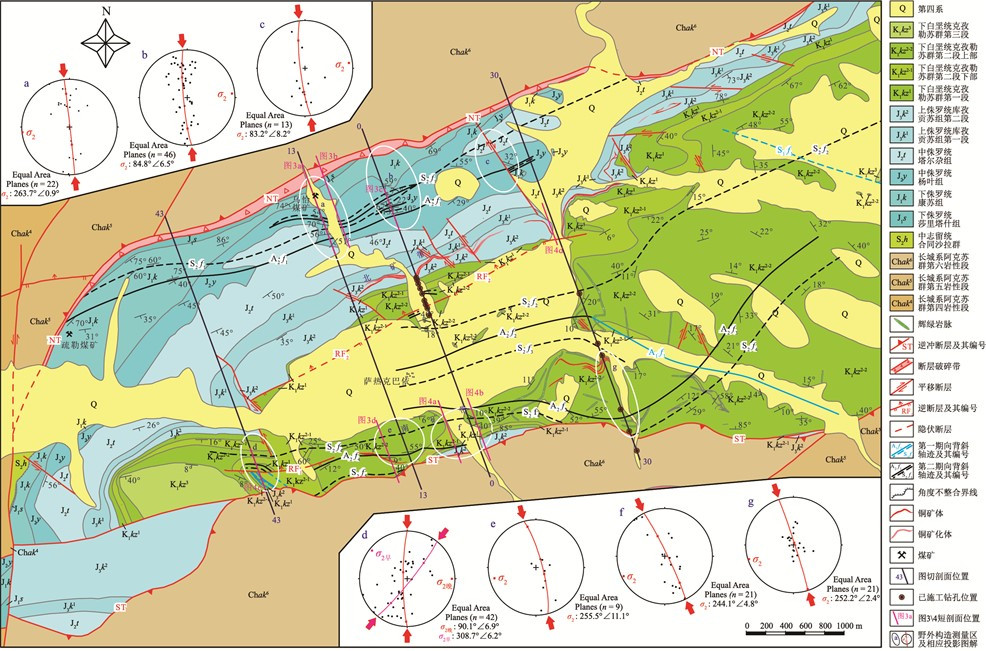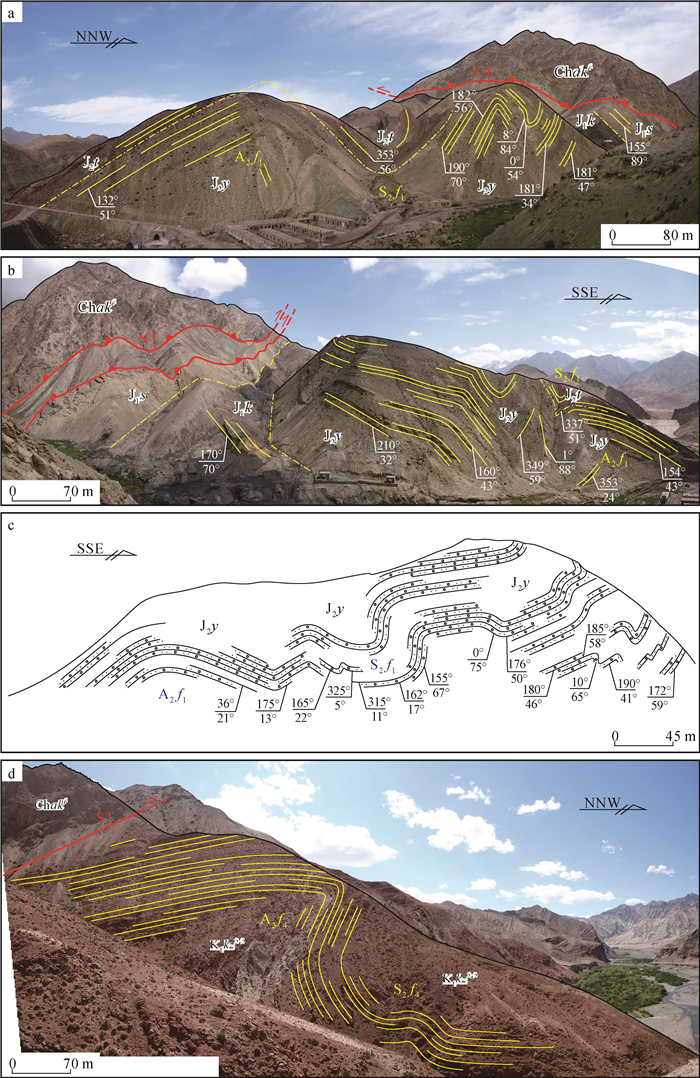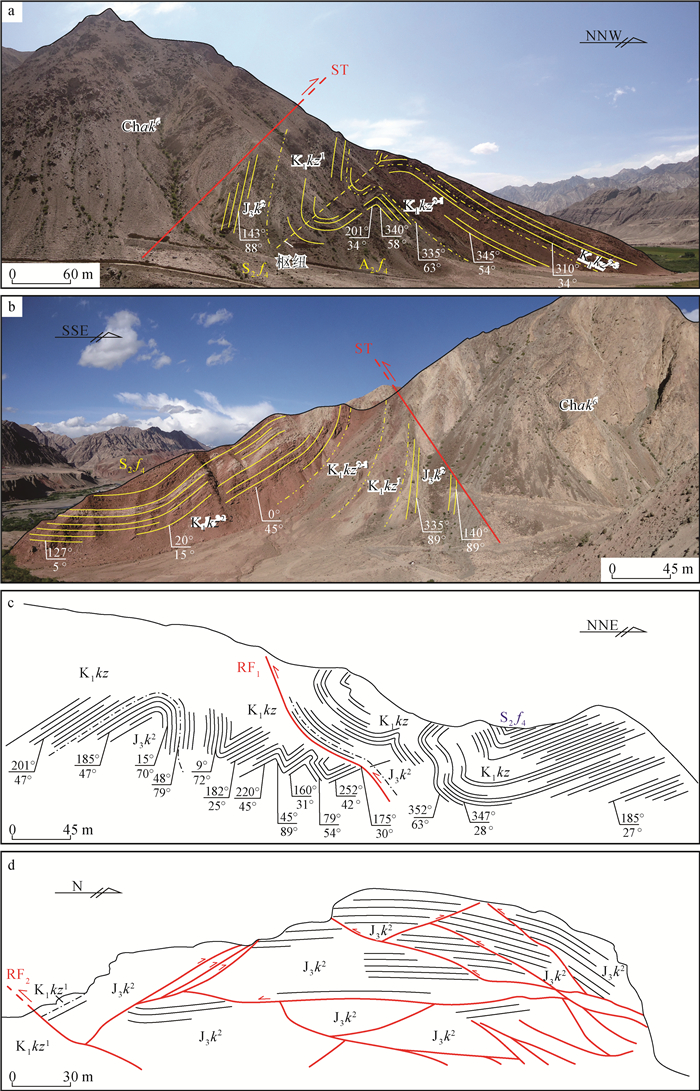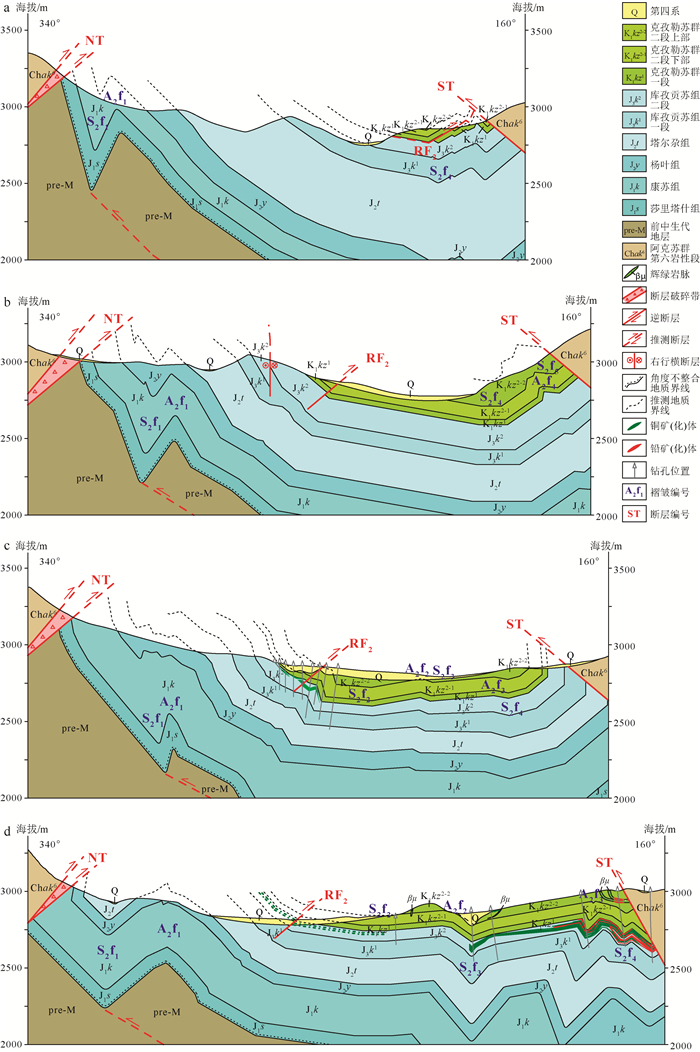Characteristics of Mesozoic-Cenozoic structural deformation in the Sarekebayi basin, Xinjiang, and its prospecting significance
-
摘要:
基于野外地质调查和构造测量工作,系统解析了萨热克巴依盆地边缘及内部的断裂-褶皱构造的几何学、运动学和动力学特征,重建盆地演化过程,探究控矿规律,促进深部找矿预测。研究表明:①盆地经历了早—中侏罗世拉分盆地发育、中侏罗世末—晚侏罗世初构造隆升剥蚀、晚侏罗世沉降、晚侏罗世末—早白垩世初构造隆升剥蚀、早白垩世早期沉降、早白垩世中晚期—古近纪隆升剥蚀、中新世压剪性构造变形、上新世—第四纪挤压收缩变形8个构造演化阶段,其中前6个阶段表现为沉降-抬升垂直运动,后2个阶段(新近纪—第四纪)表现为挤压收缩水平运动。②盆地叠加有2期挤压收缩构造变形,早期形成规模不大的北(西)西—南(东)东向宽缓向背斜构造;后期形成一系列北东东—南西西向褶皱-断层构造,表现为盆地边缘南北边界断层(ST、NT)朝盆地内对冲,导致在断层附近下盘形成的伴生褶皱趋于紧闭,而在远离断层的复式向斜(Sf)核部的次级褶皱多呈开阔宽缓状。③盆地构造控矿可以分为2个阶段:在成矿期阶段(早侏罗世—早白垩世),由盆地沉降、隆升形成的正断层、反转断层及伴生断裂-节理-裂隙为重要的导矿构造,上侏罗统库孜贡苏组砂砾岩层内发育的顺层裂隙为萨热克铜矿重要的储矿构造,导矿构造与储矿构造交汇部位成为矿液富集成矿的最佳部位;在成矿后阶段,由后期(上新世—第四纪)北北西—南南东向区域挤压应力作用形成的收缩构造变形,明显控制了矿体的空间展布形态,造成矿体卷入褶皱变形,以及被断裂-裂隙带切穿或错断。④在30勘探线以东一带,南矿带深部隐伏的库孜贡苏组上段(J3k2)为铜(锌)矿(化)体的有利赋存层位,具有良好的找矿前景。
Abstract:Based on field geological survey and structural geological survey, the authors systematically analyzed the geometry, kinematics and dynamics characteristics of the faults and folds which are at the edge and in the interior of the Sarekebayi basin, and reconstructed the evolution process of the basin so as to explore the ore-controlling rules and promote prospecting prediction at the depth. The results are as follows: ① The basin has experienced eight stages of structural evolution. i.e., the development of pull-apart basin (J1-J2), the tectonic uplift and denudation (J2-J3), the subsidence (J3), the tectonic uplift and denudation (J3-K1), the subsidence (K1), the tectonic uplift and denudation (K1-E), the compressive-shear structural deformation (N1), and the compressive structural deformation (N2-Q). There existed vertical movement of subsidence and uplift in the first six stages (J1-E) and horizontal movement of compression in the last two stages (N-Q). ② There are two stages of superimposed compressive structural deformation in the basin. In the early stage, the N(W)W-S(E)E-trending open fold with small scale was formed. In the late stage, a series of NEE-SWW trending folds and faults were formed, which showed that southern boundary fault and northern boundary fault on the margin of the basin were thrusting towards the basin, and the associated folds formed in the footwall near the faults (NF, SF) tended to be closed tightly, while the secondary folds in the core of compound syncline (Sf) far away from the faults (NF, SF) were mostly open and wide. ③ Structural ore-control of the basin can be divided into two stages. In the mineralization stage (J1-K1), the normal fault, reverse fault and associated fault-joint-crack formed by basin subsidence and uplift were the important ore-passing structures, the bedding fissures developed in the sandy conglomerate layer of Kuzigongsu Formation of Upper Jurassic were the important ore-storage structures, and the intersectional parts of ore-passing structures and ore storage structures were the best location for ore fluid enrichment and mineralization. In the post mineralization stage, the compressive structural deformation formed by the late (N2-Q) NNW-SSE regional compression obviously controlled the spatial distribution of the orebody, resulting in the involvement of the orebody in the fold deformation as well as it being cut through or staggered by the fault-crack zone. ④ In the east zone of the 30th prospecting line, Cu or Zn orebodies or mineralization bodies probably occurred in the second lithologic section of Kuzigongsu Formation, which was concealed in the depth of southern ore zone, and it has great potential for prospecting.
-
萨热克巴依中生代沉积盆地位于新疆喀什乌恰县城西北约60 km处,面积约140 km2,所属大地构造位置为西南天山复合造山带-塔里木地块西端-帕米尔高原北缘等盆-山-原镶嵌构造区[1]。自侏罗纪以来,盆地内陆续接受中—下侏罗统冲积扇-沼泽-湖相、上侏罗统冲积扇-河流相、下白垩统湖相沉积,并经历燕山期和喜马拉雅期构造活动[2],最终形成萨热克巴依盆地现今的构造-地貌特征(图 1)。
萨热克铜矿床产在萨热克巴依盆地中,发现于20世纪50年代,普查评价为小型岩浆热液型铜矿床。自20世纪90年代末以来,以矿床地质、地球化学、找矿潜力分析等研究成果[4-8]为支撑,在矿床深部与外围地区取得找矿突破,萨热克铜矿被证实为大型铜矿床。关于矿床成因的认识尚有分歧,存在与盆地卤水[9]作用有关的层控低温热液型[10]、与盆地流体有关的砾岩型[11]、热卤水溶滤沉积-构造叠加型[12]、岩性-岩相-流体多因素多重耦合型[13-16]等多种观点。
萨热克铜矿受构造控制明显,相关研究主要集中在成矿前盆地构造系统和沉积成岩成矿期构造等方面[2, 13, 15, 17]。贾润幸等[18]通过沥青-辉铜矿铼-锇同位素定年,识别了萨热克铜矿有早、中、晚3个成矿阶段,分别对应地质年龄为220±3~180±3 Ma、166.3±2.8 Ma、136.1±2.6~116.4±2.1 Ma。那么早白垩世末以后的区域性构造变形势必会在萨热克巴依地区有所响应,倘若缺少对这些成矿期后构造的研究,可能会制约该矿床的找矿预测。另外,萨热克巴依盆地在经历变形后形成裙边式复式向斜构造[2],反映出叠加褶皱的变形特征,但由于缺少相关研究,不能全面建立构造变形与成矿之间的时空耦合关系,也会制约该矿床的找矿预测。
本文基于大量详实的野外地质调查和构造测量工作,系统解析了盆地边缘及内部的断裂-褶皱构造的几何学、运动学、动力学特征,重建盆地演化过程,在前人研究基础上进一步探究控矿规律,促进萨热克铜矿深部找矿预测。
1. 萨热克巴依盆地地质背景
萨热克巴依盆地的南北边界均为断层,盆内发育侏罗系、白垩系与第四系,整体超覆在长城系或中志留统变质岩系之上,萨热克矿床产于上侏罗统中(图 2)。
1.1 地层及岩浆活动特征
盆地外缘发育中元古界长城系阿克苏群(Chak)和中志留统合同沙拉群(S2h),前者在区内广泛出露,后者仅在盆地西缘小面积出露。阿克苏群为一套钙质片岩、云母石英片岩夹大理岩,根据岩性组合可细分成6个岩系,其中第六岩性段棕褐色石英黑云母片岩LA-ICP-MS锆石U-Pb年龄测定显示其年龄加权平均值为1528±140 Ma(MSWD=4.6)[2]。合同沙拉群岩性为浅灰色、灰白色变质砂岩、绢云千枚岩、板岩,与阿克苏群呈断层接触。
盆地内发育地层从老到新依次为:①下侏罗统莎里塔什组(J1s)灰绿色砾岩夹砂岩透镜体,分别与下伏合同沙拉群呈角度不整合接触,与阿克苏群呈断层接触。②下侏罗统康苏组(J1k)黄灰色、浅灰色细粒石英砂岩,灰黑色泥岩夹煤线,与下伏莎里塔什组呈整合接触关系。③中侏罗统杨叶组(J2y)灰绿色泥岩夹砂岩、炭质泥岩及粉砂岩夹煤线,与下伏康苏组呈整合接触关系。④中侏罗统塔尔尕组(J2t)杂色泥岩、粉砂岩夹砂岩及砾岩透镜体,与下伏杨叶组呈整合接触关系;⑤上侏罗统库孜贡苏组与下伏塔尔尕组呈平行不整合接触关系,可细分为2个岩性段,其中一段(J3k1)岩性为暗红色、棕红色砾岩、砂岩及粉砂岩互层,二段(J3k2)岩性为灰绿色砾岩夹砂岩透镜体(萨热克矿体的赋矿层位);⑥下白垩统克孜勒苏群与下伏库孜贡苏组呈平行不整合接触关系,可细分成3个岩性段,一段(K1kz1)褐红色泥岩夹砂岩,二段下部(K1kz2-1)褐灰色岩屑石英砂岩夹粉砂质泥岩、暗褐灰色粉砂质泥岩夹褐灰色泥质岩屑砂岩,二段上部(K1kz2-2)褐红色长石岩屑砂岩、粉砂质泥岩夹灰绿色粉砂质泥岩,三段(K1kz3)灰色-灰绿色砾岩、薄层砂岩、泥岩。
区内未见火山岩出露,仅在南矿带地表出露辉绿岩群(图 2),呈岩墙、岩脉的形式产出,出露宽0.5~1 m,延长20~1000 m,顺层或切层侵入下白垩统中。辉绿岩脉及上下盘砂岩有褪色变质及铜矿化现象。
1.2 萨热克矿体特征
萨热克矿床由南、北2个矿带构成,分别位于萨热克巴依复式向斜(Sf)的南北两翼,其中具有经济价值的铜矿体可以分为砾岩型与含砾砂岩型。按照矿物组合可将萨热克矿床分为辉铜矿型矿石、黄铜矿型矿石,辉铜矿型矿石分布于北带,范围广、延深大;黄铜矿型矿石主要见于南矿带深部。
北矿带矿体呈层状、透镜状产于侏罗纪库孜贡苏组上段(J3k2)砾岩层位中,矿化层北东东向延长大于2 km,厚2~10 m,倾向上大体沿砾岩层延深,南倾,控制延深大于500 m。铜矿(化)体严格层控,向深部呈厚大透镜状,可见铜矿(化)体分布于砾岩层位的顶部、中部和底部,品位自上而下逐渐降低。矿体Cu品位为0.66%~1.18%,最高达10%,共伴生Ag品位较低,约为12 g/t[19]。矿石金属矿物主要为辉铜矿和孔雀石,其次为黄铜矿、铜蓝、蓝铜矿、斑铜矿、黝铜矿、闪锌矿、黄铁矿等。其中,辉铜矿和孔雀石是最主要的矿石矿物,分布广泛;黄铜矿仅见于矿带深部钻孔中。蚀变主要表现为容矿地层的大规模褪色,也可见硅化、绢云母化、碳酸盐化等蚀变。
南矿带矿(化)体主要产于上侏罗统库孜贡苏组上段,地表露头较少,以隐伏矿(化)体为主,包括铜矿(化)体及铅锌矿(化)体,层控特征明显。金属矿物主要为黄铜矿、方铅矿,其次为辉铜矿、斑铜矿、闪锌矿。其中黄铜矿、方铅矿为最主要的矿石矿物,多呈浸染状分布于砂、砾石间,或细脉状,或呈小团块状星点状分布于岩石裂隙中。早白垩世克孜勒苏群二段(K1kz2)铜铅矿化位于辉绿岩脉周边褪色化带中。
2. 盆地构造格局及变形特征
萨热克巴依盆地的南北边界分别为逆冲断层ST与逆冲断层NT所限,现今残存的含铜盆地整体表现为走向北东70°—南西250°,东宽西窄的(萨热克巴依)复式向斜构造Sf(图 2)。
2.1 褶皱构造特征
萨热克巴依盆内发育一系列向斜和背斜构造,复式向斜(Sf)北翼(盆地北部)主要由次级向斜S2f1与次级背斜A2f1构成,核部(盆地中部)主要由次级向斜S2f2、S2f3与次级背斜A2f2构成,南翼(盆地南部)主要由次级向斜S2f4、S2f5与次级背斜A2f3、A2f4构成(图 2)。此外,盆内还发育有一系列北(西)西向的褶皱构造,以向斜S1f1与背斜A1f1为代表,规模相对较小。
2.1.1 复式向斜(Sf)
(1) 北翼几何学与运动学特征
向斜S2f1与背斜A2f1均自疏勒煤矿北部呈北东东向展布,延伸至30线以东一带,区内地表出露长度分别约6 km、5 km。
向斜S2f1南西西端与北东东端均被北边界逆冲断层(NT)破坏,隐伏于阿克苏群六段变质结晶基底之下。核部出露最新地层为塔尔尕组砂岩;北翼地层整体倾向南南东方向,倾角较陡,临近北边界逆冲断层(NT)的局部地层甚至发生倒转;南翼地层整体倾向北北西,倾角为20°~85°。另外,向斜S2f1局部还发育伴生构造,位于9线—13线一带(图 3-a、b),北翼发育“Z”型次级褶皱变形(自南向北观测),显示出朝北的运动学极性;位于0线东侧一带(图 3-c),北翼同样发育“Z”型次级褶皱变形(自南向北观测),南翼发育“S”型次级褶皱变形(自南向北观测),分别显示出变形地层自向斜核部向远离转折端部位滑动特征,表明其是纵弯褶皱变形的结果。
![]() 图 3 盆地边缘或内部沿0-2线、9线、13线、17线一带发育的构造变形a—位于13线一带,北边界逆冲断层(NT)及其下盘褶皱变形;b—位于9线一带,北边界逆冲断层(NT)及其下盘褶皱变形;c—位于0-2线一带,北边界逆冲断层(NT)下盘发育的褶皱变形;d—位于17线一带,南边界逆冲断层(ST)及其下盘褶皱变形。K1kz2-2—克孜勒苏群二段上部;J2t—塔尔尕组;J2y—杨叶组;J1k—康苏租;J1s—莎里塔什组;Chak6—阿克苏群六段;ST、NT—断层编号;A2f1、A2f4、S2f1、S2f4—褶皱编号Figure 3. Structural deformation developed along 0-2, 9, 13 and 17 lineson the margin or in the interior of the basin
图 3 盆地边缘或内部沿0-2线、9线、13线、17线一带发育的构造变形a—位于13线一带,北边界逆冲断层(NT)及其下盘褶皱变形;b—位于9线一带,北边界逆冲断层(NT)及其下盘褶皱变形;c—位于0-2线一带,北边界逆冲断层(NT)下盘发育的褶皱变形;d—位于17线一带,南边界逆冲断层(ST)及其下盘褶皱变形。K1kz2-2—克孜勒苏群二段上部;J2t—塔尔尕组;J2y—杨叶组;J1k—康苏租;J1s—莎里塔什组;Chak6—阿克苏群六段;ST、NT—断层编号;A2f1、A2f4、S2f1、S2f4—褶皱编号Figure 3. Structural deformation developed along 0-2, 9, 13 and 17 lineson the margin or in the interior of the basin背斜A2f1南西西端同样被北边界逆冲断层(NT)破坏,隐伏于阿克苏群六段变质结晶基底之下,北东东端在30线以西一带过渡为朝北东东方向侧伏,并于30线以东一带灭失。核部出露最老地层为康苏组含煤砂泥岩;北翼与向斜S2f1的南翼毗邻;南翼地层整体倾向南南东,临近背斜核部部位的地层较陡,倾角为40°~70°,远离核部部位的地层逐渐缓倾。背斜A2f1北翼较南翼陡,轴面倾向南南东,倾角为70°~80°。
(2) 核部几何学与运动学特征
向斜S2f2西段多隐伏于第四系之下,翼部地层断续出露,北东东端延伸至区外,区内地表出露长度约5.4 km。向斜西段、东段均呈北东东向展布,而中段呈北东向延伸,轴迹整体呈“S”型展布。核部出露最新地层为克孜勒苏群二段,转折端宽缓;向斜西段,北翼地层产状为155°~165°∠40°~45°,南翼地层产状为300°~355°∠10°~20°,轴面整体倾向北北西,倾角为70°~75°;向斜中段轴面近于直立,南北两翼地层对称,分别倾向北西与南东,倾角为15°~25°;向斜东段隐伏于第四系之下。
背斜A2f2整体呈北东东向延伸,其北西翼零星出露地表,与向斜S2f2南翼毗邻。该背斜东段在30线附近出露地表,核部地层为克孜勒苏群二段;北翼地层产状为300°∠20°,南翼地层为245°∠10°;枢纽呈近东西向,向西侧伏,侧伏角约为15°,显示出叠加褶皱特征。
向斜S2f3全部隐伏于第四系之下,根据其两侧背斜几何学特征,推测该向斜自萨热克巴依北部呈北东东向延伸,至30线西侧转变成南东东向,并于30线东侧附近灭失。向斜东段的几何形态基本由钻孔控制,北翼地层倾角为30°~40°,南翼地层倾角为10°~20°。
(3) 南翼几何学与运动学特征
背斜A2f3整体呈北东东向展布,西端在0线附近隐伏于第四系之下,东端在30线以东一带灭失于克孜勒苏群二段上部砂岩中,地表出露长度超过4 km。背斜轴迹波状弯曲,核部出露最老地层为克孜勒苏群二段。背斜西段走向近东西,北翼多隐伏于第四系之下,地层产状为305°∠11°,南翼地层平缓,产状为170°~200°∠5°~10°,翼间角宽缓,轴面近直立;背斜中段呈南东东向展布,两翼倾角相近,产状分别为225°∠52°、345°∠55°,轴面近直立;背斜东段向北东向延伸,北西翼产状为310°~325°∠15°~25°,南东翼产状为90°~140°∠10°~35°。
向斜S2f4自43线西部呈北东东向延伸,地表出露长度超过6 km。向斜南西西端灭失于克孜勒苏群二段,中部受南边界逆冲断层(ST)破坏致隐伏于阿克苏群六段变质结晶基底之下,北东东端灭失于克孜勒苏群二段。向斜轴迹波状弯曲,核部出露最新地层为克孜勒苏群二段。向斜西段走向近东西,北翼地层较缓,产状为170°~180°∠6°~25°;南翼地层较陡,产状为300°~340°∠39°~80°,局部直立甚至倒转;轴面倾向南南东,倾角为60°~80°,为明显的不对称褶皱(图 3-d、图 4-b),具有朝向北北西方向的运动学极性;向斜东段呈北东向展布,北西翼与背斜A2f3南东翼毗邻,南东翼产状为305°~325°∠15°~60°。
![]() 图 4 盆地边缘或内部沿0线、4线、30线、43线一带发育的构造变形a—位于4线一带,南边界逆冲断层(ST)及其下盘褶皱变形;b—位于0线一带,南边界逆冲断层(ST)及其下盘褶皱变形;c—位于43线一带,南边界逆冲断层(ST)下盘发育的断裂-褶皱变形;d—位于30线一带,盆地中部逆断层(RF2)及其上盘次级破裂变形。K1kz2-2—克孜勒苏群二段上部;K1kz2-1—克孜勒苏群二段下部;K1kz1—克孜勒苏群一段;K1kz—克孜勒苏群(未分段);J3k2—库孜贡苏组上段;Chak6—阿克苏群六段;ST、RF1、RF2—断层编号;A2f4、S2f4—褶皱编号Figure 4. Structural deformation developed along 0, 4, 30 and 43 lineson the margin or in the interior of the basin
图 4 盆地边缘或内部沿0线、4线、30线、43线一带发育的构造变形a—位于4线一带,南边界逆冲断层(ST)及其下盘褶皱变形;b—位于0线一带,南边界逆冲断层(ST)及其下盘褶皱变形;c—位于43线一带,南边界逆冲断层(ST)下盘发育的断裂-褶皱变形;d—位于30线一带,盆地中部逆断层(RF2)及其上盘次级破裂变形。K1kz2-2—克孜勒苏群二段上部;K1kz2-1—克孜勒苏群二段下部;K1kz1—克孜勒苏群一段;K1kz—克孜勒苏群(未分段);J3k2—库孜贡苏组上段;Chak6—阿克苏群六段;ST、RF1、RF2—断层编号;A2f4、S2f4—褶皱编号Figure 4. Structural deformation developed along 0, 4, 30 and 43 lineson the margin or in the interior of the basin背斜A2f4南西西端灭失于克孜勒苏群一段,自43线东部朝北东东向延伸至0线一带,北东东端灭失于库孜贡苏组上段,地表出露长约1.6 km。核部出露最老地层为库孜贡苏组上段,北翼与向斜S2f4南翼毗邻,南翼地层较缓,为轴面南倾的斜歪褶皱(图 3-d,图 4-a),具有朝向北北西方向的运动学极性。
向斜S2f5呈北东东向展布,两端均被南边界逆冲断层(ST)破坏,地表出露长约1 km。核部出露克孜勒苏群二段,北翼地层相比南翼地层较缓,产状分别为150°~180°∠8°~15°、320°~340°∠40°,轴面倾向南南东,显示出朝向北北西方向的运动学极性。
2.1.2 北(西)西向褶皱
背斜A1f1西起30线附近,与背斜A2f2相接,呈南东东向延伸,其南东端被南边界逆冲断层(ST)破坏,地表出露长度约2 km。背斜核部多由第四系覆盖,出露最新地层为克孜勒苏群二段;北东翼地层倾向北北东,倾角为15°~31°,南西翼地层倾向南西,倾角为10°~14°,翼间角宽缓,轴面朝南西向陡倾。
向斜S1f1西起30线东侧一带,呈南东东向延伸至区外,其南东端被亦南边界逆冲断层(ST)破坏,地表出露长度约5 km(含区外)。该向斜的几何形态代表了萨热克巴依盆地东部的褶皱变形样式,核部多被第四系覆盖,出露最新地层为克孜勒苏群三段;向斜西段,北东翼和南西翼地层产状为150°~165°∠45°~60°、65°~85°∠30°~45°,枢纽产状为100°∠35°,显示出叠加褶皱的变形特征;向斜中东段,两翼地层产状分别为200°~220°∠9°~15°、25°~45°∠35°~45°,枢纽近水平。
2.2 断裂构造特征
萨热克巴依盆地南边界逆冲断层(ST)与北边界逆冲断层(NT)活动强烈,对盆地内发育的褶皱变形有明显的控制作用。另外,在盆地中部和南缘还分别发育次级断裂RF1与RF2,二者规模较小,均为逆断层(图 2),以及一系列横断层。
2.2.1 北边界逆冲断层(NT)
北边界逆冲断层(NT)整体呈北东东—南西西向展布,表现为断层上盘长城系阿克苏群朝向南南东方向逆冲至下盘莎里塔什组、康苏组、杨叶组、塔尔尕组构成的褶皱变形(向斜S2f1、背斜A2f1)之上(图 3-a、b),断层倾角为50°~75°,区内地表出露长度约9.6 km。断层南西端在盆地西南缘一带,受近南北向横断层的破坏,在左行走滑的牵引作用下,临近横断层的部位转变为北北东走向。
2.2.2 南边界逆冲断层(ST)
南边界逆冲断层(ST)南西端同样受到近南北向横断层的破坏,整体朝北东东方向延伸至区外,表现为断层上盘长城系阿克苏群变质岩系朝向北北西方向逆冲至下盘塔尔尕组、库孜贡苏组、克孜勒苏群构成的褶皱变形(向斜S2f4、S2f5与背斜A2f3、A2f4)之上(图 3-d,图 4-a、b),断层倾角为40°~65°,区内地表出露长度约10 km。
2.2.3 逆断层RF1
逆断层RF1发育在南边界逆冲断层(ST)下盘,自43线西部延伸至13线西部,呈北东东—南西西向展布,地表出露长约1.2 km。该断层南西西端与北东东端均灭失于克孜勒苏群二段上部砂岩中,表现为上盘克孜勒苏群和库孜贡苏组构成的近东西向褶皱变形(向斜S2f4)向南逆冲到下盘克孜勒苏群、库孜贡苏组构成北西向褶皱变形上(图 2)。
在43线一带,断层RF1产状为355°∠30°,可见上盘向斜S2f4南翼的库孜贡苏组沿上盘断坡向南逆冲至下盘强烈变形的褶皱构造之上(图 4-c),且在向斜S2f4的核部还发育一系列斜歪-倒转次级褶皱构造,呈“W”形排列。断层下盘发育一对向背斜构造,均向南东方向延伸至南边界逆冲断层(ST)上盘,隐伏于阿克苏群变质岩系之下,地表出露长度均约300 m;向斜核部出露最新地层为克孜勒苏群砂岩,北东翼部发育次级“Z”型褶皱(自西向东观测),南西翼地层相比北东翼地层较陡,为不对称向斜,具有向北东方向的运动学极性;背斜核部出露最老地层为库孜贡苏组砾岩,北东翼毗邻向斜南西翼,为不对称背斜,同样具有向北东方向的运动学极性。
2.2.4 逆断层RF2
逆断层RF2发育在萨热克巴依复式向斜(S2f)北北西翼与轴部过渡部位,呈北东东—南西西向展布,自43线东部延伸至30线东部一带,隐伏于第四系之下,地表断续出露,长约3.9 km。该断层南西西端止于北北西向横断层,北东东端灭失于克孜勒苏群一段砂岩中,表现为上盘库孜贡苏组和克孜勒苏群向南逆冲到下盘克孜勒苏群之上。在临近断层部位,上盘与下盘地层均倾向南南东,前者倾角为25°~55°,后者较平缓,倾角为5°~25°。
在30线一带,断层RF2产状为355°∠40°,可见上盘库孜贡苏组上段含铜砾岩朝南南东方向逆冲至下盘克孜勒苏群砂岩之上(图 4-d)。断层上盘库孜贡苏组砾岩不具有各向异性,或具有弱各向异性,从而形成一系列次级破裂面,包括小断层和共轭节理,这些构造面理的走向与主断层RF2一致,倾向北北西或南南东,倾角为20°~40°。
2.2.5 横断层
盆地内发育多条横断层,主要分布在萨热克巴依复式向斜(Sf)北翼(图 2),多呈北北西—南南东向展布,倾角较陡,地表出露长度数百米至1 km不等。这些横断层主要表现为对康苏组、杨叶组、塔尔尕组、库孜贡苏组、克孜勒苏群构成的褶皱变形(向斜S2f1与背斜A2f1)或者单斜岩层,起到右行或者左行错断作用,水平断距达数十米至数百米不等。
2.3 碎裂岩化相特征
受控于断裂-褶皱-流体作用,在萨热克巴依盆地内还广泛发育节理、裂隙等小型-微型构造,形成碎裂岩化相。根据区内碎裂岩化相产出的形态及位置,可以分成3类:①切层分布的碎裂岩相,主要受区内北东向断裂构造的控制,一般分布在断层带内或附近,随着远离断裂带,碎裂岩化逐渐减弱;②顺层分布的碎裂岩化相,主要受控于成矿流体压力作用与褶皱作用,多发育在顺层矿体与矿化蚀变带,以及褶皱核部与附近翼部地层的层间断裂或裂隙部位,尤其是分布在砾岩类和含砾粗砂岩中或含砾粗砂岩和粉砂质泥岩-泥质粉砂岩过渡部位,随着矿化蚀变减弱或远离层间滑动断层,变形特征表现为由碎裂岩化相砾岩逐渐过渡为弱碎裂岩化相砾岩;③多组断裂-裂隙带交汇部位的碎裂岩化相,其碎裂岩化最强。
3. 中新生代盆地构造演化
萨热克巴依中新生代盆地自形成至今先后经历了2类构造运动相关的8个构造演化阶段。早期(早侏罗世—古近纪)在无褶皱变形发育的垂直运动构造背景下,区内交替发生沉降、抬升运动,可细分成6个阶段,表现为断续接受河-湖相沉积,形成萨热克巴依断陷盆地;遭受抬升剥蚀,形成一系列平行不整合界面。后期(新近纪至今)在陆内造山作用下,受控于水平挤压收缩体制,形成了褶皱-断裂构造组合样式,其地质演化过程分为2个阶段。
3.1 早侏罗世—古近纪沉降-抬升垂直运动
(1) 早—中侏罗世拉分盆地发育阶段
受控于塔拉斯-费尔干纳断裂的右行走滑拉分作用,形成托云断陷盆地[20-26](亦有国内学者称库孜贡苏盆地,国外学者称Yarkand-Fergana盆地)与萨热克巴依次级盆地[2],以及连续沉积的中—下侏罗统。早侏罗世早期,盆地开始进入沉降期,形成莎里塔什组(J1s)一套快速堆积的冲积扇相体(砾岩)。早侏罗世晚期—中侏罗世早期,盆地进入稳定沉降期,形成康苏组(J1k)一套湖泊-沼泽相的煤系地层和杨叶组(J2y)一套滨浅湖相灰绿色砂岩-泥岩组合。中侏罗世晚期,随着盆地进一步沉降,水体不断加深而形成塔尔尕组(J2t)一套浅湖-半深湖-深湖相杂色泥岩、石英砂岩夹泥灰岩。
(2) 中侏罗世末—晚侏罗世初构造隆升剥蚀阶段
上侏罗统库孜贡苏组(J3k)与下伏中侏罗统杨叶组(J2y)之间存在沉积间断,二者岩性、粒序突变明显,表现为冲积扇-河流相砾岩呈平行不整合覆盖在半深湖相泥岩之上,反映在中侏罗世末—晚侏罗世初,萨热克巴依盆地及周围山系处于无褶皱变形发育的整体隆升的构造环境,可能与区域上拉萨地块与欧亚板块碰撞[27]有关。方维萱等[28]在塔西乌拉根一带测得沉积碎屑锆石裂变径迹年龄为159±7 Ma(沉积锆石裂变径迹法年龄),对应该期构造抬升运动,揭示萨热克巴依盆地南侧苏鲁铁列克结晶基底在晚侏罗世初经历了强烈隆升和剥蚀,能够提供大量蚀源岩区物质。
(3)晚侏罗世沉降阶段
盆地内又一次接受河流相砾岩、砂岩、粉砂岩至冲积扇相砾岩沉积,即库孜贡苏组(J3k)。现今盆地南北两侧库孜贡苏组砾石均由北北东流向的古水流搬运而来[29-30],而且经盆内钻孔岩心对比,盆地北侧(萨热克铜矿北矿带)是盆地内库孜贡苏组沉积最厚的位置[30],指示该时期盆地南缘的苏鲁铁列克隆起为重要物源区,以及南高北低的古地势。
(4) 晚侏罗世末—早白垩世初构造隆升剥蚀阶段
下白垩统克孜勒苏群(K1kz)与下伏上侏罗统库孜贡苏组(J3k)呈平行不整合接触关系,指示在晚侏罗世末—早白垩世初,萨热克巴依盆地隆升并遭受剥蚀。方维萱等[28]测得,塔西杨叶铜矿三采场一带的沉积碎屑锆石裂变径迹年龄为145±7 Ma(沉积锆石裂变径迹法年龄),揭示在晚侏罗世末—早白垩世初期,盆地南缘苏鲁铁列克垂向基底隆起,构造抬升强烈,提供蚀源岩区物质。此次构造隆升未造成地层褶皱变形,可能受晚侏罗世—早白垩世(最有可能140~130 Ma)拉萨和羌塘地块之间的班公洋封闭[31]影响。
(5) 早白垩世早期沉降阶段
早白垩世早期(克孜勒苏期第一、二阶段),随着水体加深,盆内开始接受滨浅湖相浅紫红色砂岩-粉砂岩-泥岩组合。
(6) 早白垩世中晚期—古近纪隆升剥蚀阶段
虽然现今在萨热克巴依盆地内并未保留晚白垩世—古近纪地层,但是仍可以根据其周缘地区记录的沉积岩、岩浆岩信息,反演该时期萨热克巴依盆地经历的构造事件。
① 早白垩世中晚期构造隆升阶段
现今萨热克巴依盆地内出露最新地层是下白垩统克孜勒苏群三段,为一套山间盆地河流相沉积[2],岩性由下至上依次为岩屑砂岩、含砾砂岩、灰绿色、灰白色砾岩,显出水体环境明显变浅的特征。在乌拉根一带,克孜勒苏群发育完整,出露5个岩性段,显示向上变浅-变粗的沉积序列。综上,在早白垩世中晚期(克孜勒苏期第三、四、五阶段),萨热克盆地发生了隆升运动。在乌拉根一带,克孜勒苏群第五岩性段中沉积碎屑锆石裂变径迹年龄为119±6 Ma[28](沉积锆石裂变径迹法年龄),对应该期构造隆升事件,可能与羌塘-拉萨地块拼合后板块断裂和相关地幔熔融事件引起的构造岩浆活动[32-33]有关。
② 晚白垩世—古近纪剥蚀阶段
位于苏鲁铁列克古隆起的南侧,距离萨热克巴依盆地南东方向约40 km的吾合沙鲁北—康西—乌拉根—吉勒格一带,缺失晚白垩世沉积,与古新统阿尔塔什组呈平行不整合,局部呈微角度不整合覆盖在克孜勒苏群之上;在托云盆地周边,古近系喀什群与克孜勒苏群呈平行不整合接触;在托帕铅锌矿区,始新统卡拉塔尔组以平行不整合超覆在克孜勒苏群之上。区域上普遍发育的克孜勒苏群及其上覆地层间的平行不整合界面或微角度不整合界面表明,晚白垩世萨热克巴依盆地暴露地表遭受剥蚀。
托云盆地内白垩纪—古近纪(122.2~54.1 Ma,K-Ar法)[34]玄武岩来源于较低熔融程度的富集地幔,指示陆内伸展构造环境[35-36]。在萨热克巴依盆地内的克孜勒苏群中侵入有辉绿岩脉,其岩石地球化学特征与托云盆地玄武岩极其相似,二者应为同源产物[37],指示萨热克巴依盆地在晚白垩世—古近纪亦处在伸展构造环境内。
晚白垩世—古近纪,受新特提斯洋沿印度河-雅鲁藏布缝合带的向北俯冲作用[38],萨热克周缘地区广泛发生沉降与海侵事件[39-40],而萨热克巴依地区表现为古隆起,不接受同时期沉积。
3.2 新近纪—第四纪挤压收缩水平运动
受印度板块与欧亚板块碰撞的远程效应影响[41],萨热克巴依盆地经历了2个变形阶段,早期以压剪性走滑构造变形为主,晚期以近南北向挤压收缩变形为主,与该时期塔里木盆地演化过程[42]一致。
3.2.1 中新世压剪性构造变形阶段
中新世,受控于塔拉斯-费尔干纳断裂第三阶段右行走滑运动[21, 25-26],形成北(北)东—南(南)西向的次级挤压应力场,在萨热克巴依盆地内发育北西向、北西西向宽缓褶皱构造,与该时期在库孜贡苏盆地内大量发育的轴面倾向南西的褶皱构造[39]对应。
北(北)西—南(南)东向褶皱变形强度较弱,盆内保留的构造形迹不明显,多表现为翼间角宽缓的向背斜构造,以背斜(A1f1)、向斜(S1f1)为代表。局部发育次级斜歪褶皱,以43线一带逆断层RF1下盘克孜勒苏群中的向背斜构造为代表,整体枢纽产状为308°∠6°,其北西端和南东端分别被后期逆断层RF1、南北边界逆冲断层(ST)冲断破坏(图 2、图 4-c)。
3.2.2 上新世—第四纪近挤压收缩变形阶段
自上新世以来,青藏高原及中亚地区以强烈挤压、地壳增厚为主要特征[42],且塔里木盆地边缘造山带的强度不断增加[43-44]。喀什地区新生代磨拉石主要集中在中新世末期—上新世初[45-46],反映该地区大规模的冲断变形始于上新世初期[47],以及萨热克巴依地区亦有响应。随着帕米尔地体强烈向北逆冲并与南天山造山带相顶撞,在近南北向(北北西—南南东向)区域挤压应力作用下,萨热克巴依盆地内中、新生代地层强烈变形,形成了北东东—南西西向褶皱-断裂构造,以盆地南北边界逆冲断层(ST、NT)、盆内逆断层(RF1、RF2)及复式向斜(Sf)为代表,局部伴随发育北北西向横断层,共同奠定了现今萨热克巴依盆地的“对冲式”构造格局。其中南北边界逆冲断层(ST、NT)分别向南、北陡倾,临近断层部位的地层多为陡倾,甚至倒转,以及次级褶皱也趋于紧闭;萨热克复式向斜(Sf)核部地层较为平缓,形成的次级褶皱多呈开阔宽缓状(图 5)。此外,该阶段形成的北东东—南西西向褶皱-断裂构造表现出朝向北北西或朝向南南东的运动极性及纵弯褶皱的变形特征。
(1) 具北北西朝向运动极性的构造变形
主要分布在盆地西南缘,由盆地南边界逆冲断层(ST)向北北西方向运动为主导,在该断裂下盘发育向斜(S2f5)、背斜(A2f4)、向斜(S2f4),均具有向北北西的运动极性,构成“Z”形褶皱组合(由南向北观测),有别于(萨热克巴依)复式向斜(Sf)南翼由向斜(S2f4)和背斜(A2f3)构成的“S”形褶皱组合(由南向北观测)。
(2) 具南南东朝向运动极性的构造变形
以盆地北边界逆冲断层(NT)及盆内逆断层RF1、RF2为代表,表现为各断裂上盘朝向南南东方向逆冲,并造成盆地北缘次级向斜(S2f1)北翼的杨叶组中发育“S”形挠曲构造(由南向北观测)(图 3-c),而有别于纵弯褶皱作用形成的“Z”形挠曲构造(由南向北观测)。
(3) 纵弯褶皱变形
以(萨热克巴依)复式向斜(Sf)核部及远离盆地南北边界逆冲断层(ST、NT)的翼部中发育的褶皱构造为代表(图 5),其核部发育向斜S2f2、S2f3与背斜A2f2,三者共同构成核部的“W”形次级褶皱;北北西翼发育向斜S2f1、背斜A2f1,二者共同构成翼部的“Z”形次级褶皱(由南向北观测);南南东翼发育背斜A2f3、向斜S2f4,共同构成翼部的一系列“S”形次级褶皱(由南向北观测)。另外,该期北东东—南西西向褶皱变形叠加改造了早期北(西)西—南(东)东向褶皱构造(图 2),导致①褶皱轴迹弯曲,如背斜(A1f1)西段的轴迹由北西西向转变为北东东向,形成背斜(A2f2);②小型穹隆构造的形成,如背斜(A1f1)与背斜(A2f3)的交汇部位;③褶皱枢纽具有一定倾伏角,如向斜(S1f1)西段枢纽向南东东方向倾伏。
4. 构造控矿特征及意义
萨热克巴依盆地构造控矿可分为2个阶段,早侏罗世—早白垩世成矿期[18]构造控矿阶段与晚白垩世—第四纪成矿后构造改造破坏阶段。
4.1 成矿期构造控矿特征
萨热克砂砾岩型铜矿是多期构造作用和多期盆地流体活动的产物[2, 28]。铜矿体的赋矿层位为上侏罗统库孜贡苏组上段(J3k2)砾岩夹砂岩透镜体层,其下地层伏为库孜贡苏组下段(J3k1)(砾)砂岩、粉砂岩层,上覆下白垩统克孜勒苏群一段(K1kz1)褐红色泥岩夹砂岩层,共同为砾岩层中铜锌矿液的富集提供了良好的封闭环境。
该时期广泛发育构造裂隙,形成的碎裂岩化相具有明显的控矿作用[2, 14, 16, 28],且在不同构造部位表现出不同的控矿特征。由盆地沉降、隆升形成的正断层、反转断层(推测位于盆地边缘,由阿克苏群推覆体掩盖)及伴生断裂-节理-裂隙为重要的导矿构造,即切层分布的碎裂岩化相为盆地内成矿流体运移提供了良好的通道,表现为普遍伴有较强的褪色化-沥青化-铁碳酸盐化蚀变,并以褪色化、方解石化为主。上侏罗统库孜贡苏组砂砾岩层相比盆地内其他岩性层具有更优越的储矿性能,是萨热克铜矿重要的储矿构造,由于库孜贡苏组含矿层的渗透率比其他非含矿层更高[15],在成矿流体压力(222.34~500.46 MPa[9])作用下,更容易造成砂砾岩(单轴抗压强度为83.52 MPa[48])碎裂,形成顺层分布的碎裂岩化相,为盆地内矿液的聚集和沉淀提供了优越的赋存空间,即在裂隙中充填方解石细脉、白云石脉、沥青、辉铜矿、斑铜矿、黄铁矿等形成矿体,并普遍伴随有褪色化和沥青化蚀变特征。导矿构造(切层断裂-裂隙带)与储矿构造(顺层裂隙带)交汇部位形成碎裂岩化相,表现出岩石碎裂强烈及沥青化最强,是铜富集成矿最佳部位和铜-钼-银改造富集成矿最佳部位,以发育碎裂状铜矿石、细网脉状和微网脉状沥青-辉铜矿为特征。
4.2 成矿后构造控矿特征及意义
晚白垩世—古近纪,萨热克巴依地区为古隆起地势,因克孜勒苏群覆盖,含矿层并未暴露地表遭受剥蚀;以及未受到明显的水平挤压作用,含矿层也没有被褶皱-断裂构造破坏及改造。
新近纪以来,萨热克巴依盆地叠加有2期挤压收缩构造变形,其中晚期(上新世—第四纪)北北西—南南东向区域挤压应力作用对矿体的空间分布改造、破坏明显。萨热克巴依复式向斜(Sf)的北北西翼和南南东翼分别控制了北矿带和南矿带展布方向,导致①矿体卷入次级褶皱变形中(图 5-d),并被伴随发育的层间断裂-裂隙带切穿;②北矿带矿体扬起,并遭受剥蚀而暴露地表。南北边界逆冲断层(ST、NT)对矿体具有明显破坏作用,导致①南矿带矿体南延部分被冲断抬升,并遭受剥蚀而消失;②伴生的切层断裂-裂隙带切穿或错动矿体。
萨热克巴依盆地北侧剥蚀较深,侏罗系大面积出露,而且矿体也暴露地表遭受剥蚀;盆地南侧剥蚀较浅,出露地层多为白垩系,而上侏罗统砂砾岩层多隐伏于地下,并在30勘探线深部形成隐伏矿体。另外,沿着北北东方向,0勘探线以东的南边界逆冲断层下盘地层埋深具有逐渐增加的趋势。综上,在30勘探线以东一带,南矿带深部隐伏的库孜贡苏组上段(J3k2)为铜(锌)矿(化)体的有利赋存层位,可能有工业矿体产出,具有良好的找矿前景。
5. 结论
(1) 萨热克巴依盆地叠加有两期挤压收缩构造变形。早期在北(北)东—南(南)西向挤压应力作用下,形成北(西)西—南(东)东向宽缓向背斜构造,局部发育次级斜歪褶皱,但规模不大;后期持续受北北西—南南东向强烈挤压作用,形成一系列北东东—南西西向褶皱-断层构造,并造就了盆地现今“对冲式”的构造格局。盆地边缘构造变形强烈,南北边界逆冲断层(ST、NT)及附近地层多为陡倾,局部地层甚至倒转,而且伴生次级褶皱也趋于紧闭;盆内构造变形强度偏弱,复式向斜(Sf)核部地层较平缓,形成的次级褶皱多呈开阔宽缓状。
(2) 萨热克巴依中新生代盆地经历了早—中侏罗世拉分盆地发育、中侏罗世末—晚侏罗世初构造隆升剥蚀、晚侏罗世沉降、晚侏罗世末—早白垩世初构造隆升剥蚀、早白垩世早期沉降、早白垩世中晚期—古近纪隆升剥蚀、中新世压剪性构造变形、上新世—第四纪挤压收缩变形8个构造演化阶段。前6个阶段(早侏罗世—古近纪),区内交替发生沉降、抬升等垂直运动,表现为陆续接受河-湖相沉积或遭受剥蚀,以及不伴随褶皱构造发育。后两个阶段(新近纪—第四纪),区内先后发生北(北)东—南(南)西向与北北西—南南东向挤压收缩水平运动,形成了2期构造叠加的褶皱-断裂构造组合样式。
(3) 萨热克巴依盆地构造控矿可以分为成矿期构造控矿阶段(早侏罗世—早白垩世)与成矿后构造改造破坏阶段(晚白垩世—第四纪)。成矿期阶段,由盆地沉降、隆升形成的正断层、反转断层及伴生断裂-节理-裂隙为重要的导矿构造;上侏罗统库孜贡苏组砂砾岩层相比盆地内其他岩性层更易碎裂,其内发育的顺层裂隙为萨热克铜矿重要的储矿构造;导矿构造(切层断裂-裂隙带)与储矿构造(顺层裂隙带)交汇部位是矿液富集成矿的最佳部位。成矿后阶段,由后期(上新世—第四纪)北北西—南南东向区域挤压应力作用形成的收缩构造变形,明显控制矿体的空间展布形态,并造成矿体被切穿或错断。
(4) 萨热克巴依盆地南侧剥蚀较浅,在30勘探线以东一带,南矿带深部隐伏的库孜贡苏组上段(J3k2)为铜(锌)矿(化)体的有利赋存层位,可能有工业矿体产出,具有良好的找矿前景。
致谢: 感谢中国地质大学(北京)张长厚教授、审稿专家对论文撰写与修改提出的宝贵意见。 -
图 3 盆地边缘或内部沿0-2线、9线、13线、17线一带发育的构造变形
a—位于13线一带,北边界逆冲断层(NT)及其下盘褶皱变形;b—位于9线一带,北边界逆冲断层(NT)及其下盘褶皱变形;c—位于0-2线一带,北边界逆冲断层(NT)下盘发育的褶皱变形;d—位于17线一带,南边界逆冲断层(ST)及其下盘褶皱变形。K1kz2-2—克孜勒苏群二段上部;J2t—塔尔尕组;J2y—杨叶组;J1k—康苏租;J1s—莎里塔什组;Chak6—阿克苏群六段;ST、NT—断层编号;A2f1、A2f4、S2f1、S2f4—褶皱编号
Figure 3. Structural deformation developed along 0-2, 9, 13 and 17 lineson the margin or in the interior of the basin
图 4 盆地边缘或内部沿0线、4线、30线、43线一带发育的构造变形
a—位于4线一带,南边界逆冲断层(ST)及其下盘褶皱变形;b—位于0线一带,南边界逆冲断层(ST)及其下盘褶皱变形;c—位于43线一带,南边界逆冲断层(ST)下盘发育的断裂-褶皱变形;d—位于30线一带,盆地中部逆断层(RF2)及其上盘次级破裂变形。K1kz2-2—克孜勒苏群二段上部;K1kz2-1—克孜勒苏群二段下部;K1kz1—克孜勒苏群一段;K1kz—克孜勒苏群(未分段);J3k2—库孜贡苏组上段;Chak6—阿克苏群六段;ST、RF1、RF2—断层编号;A2f4、S2f4—褶皱编号
Figure 4. Structural deformation developed along 0, 4, 30 and 43 lineson the margin or in the interior of the basin
-
方维萱, 王磊, 贾润幸.塔西地区中-新生代盆-山-原镶嵌构造区:砂砾岩型铜铅锌-天青石-铀-煤成矿系统[J].地球科学与环境学报, 2018, 40(6):663-705. http://d.old.wanfangdata.com.cn/Periodical_xagcxyxb201806001.aspx 方维萱, 王磊, 郭玉乾, 等.新疆萨热克巴依盆内构造样式及对萨热克大型砂砾岩型铜矿床控制规律[J].地学前缘, 2018, 25(3):240-259. http://www.cqvip.com/QK/98600X/201803/675410461.html 杜玉龙, 方维萱, 鲁佳.新疆萨热克辉长辉绿岩类成岩温度-压力-氧逸度特征与成岩作用演化趋势[J].岩石学报, 2020, 43(3):484-508. http://www.cnki.com.cn/Article/CJFDTotal-YSXB202002010.htm 高珍权, 方维萱, 王伟, 等.沟系土壤测量在新疆乌恰县萨热克铜矿勘查中的应用效果[J].矿产与地质, 2005, 19(5):669-673. 胡庆雯, 刘宏林.新疆乌恰县萨热克砂岩铜矿床地质特征与找矿前景[J].矿产与地质, 2008, 22(2):131-134. http://www.cqvip.com/QK/96866X/20082/27991700.html 梁晓鹰.地球化学勘查在新疆萨热克铜矿的应用效果[J].新疆有色金属, 2008, 19(5):5-8. http://www.cqvip.com/QK/71135X/201107/27419915.html 刘增仁, 巴特, 田培仁, 等.新疆乌恰县萨热克砂砾岩型铜矿成矿地质特征与找矿潜力分析[J].西北地质, 2010, 43(增刊):12-16. 胡建辉, 吉蕴生, 曾志钢, 等.新疆萨热克铜矿床地球化学异常评价研究[J].矿产勘查, 2014, 5(2):281-292. http://d.wanfangdata.com.cn/Periodical/ytgcj201402021 王伟, 李文渊, 高满新, 等.塔里木陆块西北缘萨热克砂岩型铜矿床构造-流体演化对成矿的制约[J].地质通报, 2018, 37(7):1315-1324. http://dzhtb.cgs.cn/gbc/ch/reader/view_abstract.aspx?file_no=20180715&flag=1 祝新友, 王京彬, 王玉杰, 等.新疆萨热克铜矿——与盆地卤水作用有关的大型矿床[J].矿产勘查, 2011, 2(1):28-35. http://www.cqvip.com/Main/Detail.aspx?id=36416612 李志丹, 薛春纪, 辛江, 等.新疆乌恰县萨热克铜矿床地质特征及硫、铅同位素地球化学[J].现代地质, 2011, 25(4):720-729. http://d.wanfangdata.com.cn/Periodical/xddz201104013 张振亮, 冯选洁, 董福辰, 等.西南天山砂砾岩容矿矿床类型及找矿方向[J].西北地质, 2014, 47(3):70-82. http://d.wanfangdata.com.cn/periodical/xbdz201403011 方维萱, 贾润幸, 王磊, 等.新疆萨热克大型砂砾岩型铜多金属矿床的成矿控制规律[J].矿物学报, 2015, 35(增刊):202-204. http://www.cnki.com.cn/Article/CJFDTotal-KWXB2015S1150.htm 方维萱, 贾润幸, 郭玉乾, 等.塔西地区富烃类还原性盆地流体与砂砾岩型铜铅锌-铀矿床成矿机制[J].地球科学与环境学报, 2016, 38(6):727-752. http://www.cqvip.com/QK/94561C/20166/670739068.html 韩文华, 方维萱, 张贵山, 等.新疆萨热克砂砾岩型铜矿区碎裂岩化相特征[J].地球科学与环境学报, 2017, 39(3):397-405. http://www.cnki.com.cn/Article/CJFDTotal-XAGX201703009.htm 贾润幸, 方维萱, 王磊, 等.新疆萨热克砂砾岩型铜矿床富烃类还原性盆地流体特征[J].大地构造与成矿学, 2017, 41(4):1-13. http://www.cnki.com.cn/Article/CJFDTOTAL-DGYK201704009.htm 王磊, 方维萱, 鲁佳, 等.新疆乌恰地区萨热克铜矿床储矿构造样式与控矿规律[J].地球科学与环境学报, 2019, 41(1):29-39. http://www.cqvip.com/QK/94561C/20191/7001168720.html 贾润幸, 方维萱, 李建旭, 等.新疆萨热克铜矿床铼-锇同位素年龄及其地质意义[J].矿床地质, 2018, 37(1):151-162. http://www.cnki.com.cn/Article/CJFDTotal-KCDZ201801011.htm 刘宏林, 胡庆雯, 田培仁.关于新疆乌恰盆地中新生代砂岩型铅锌铜铀层次成矿问题浅析[J].矿产与地质, 2010, 24(2):113-119. http://d.wanfangdata.com.cn/Periodical/kcydz201002003 胡望水.塔里木盆地反转构造与油气聚集[J].新疆石油地质, 1995, 16(2):89-95. http://www.cnki.com.cn/Article/CJFDTotal-XJSD502.000.htm Burtman V S, Skobelev S F, Molnar P.Late Cenozoic slip on the Talas-Ferghana fault, the Tian Shan, central Asia[J].Geological Society of America Bulletin, 1996, 108(8):1004-1021. doi: 10.1130/0016-7606(1996)108<1004:LCSOTT>2.3.CO;2
罗金海, 车自成, 刘良.喀什凹陷的成因及找油方向[J].西北大学学报(自然科学版), 1998, 28(5):435-438. http://www.cnki.com.cn/Article/CJFDTotal-XBDZ805.017.htm Sobel E R.Basin analysis of the Jurassic-Lower Cretaceous southwest Tarim basin, northwest China[J].Geological Society of America Bulletin, 1999, 111(5):709-724. doi: 10.1130/0016-7606(1999)111<0709:BAOTJL>2.3.CO;2
Allen M B, Alsop G I, Zhemchuzhnikov V G.Dome and basin refolding and transpressive inversion along the Karatau Fault System, southern Kazakstan[J].Journal of the Geological Society, 2001, 158(1):83-95. doi: 10.1144/jgs.158.1.83
Bande A, Sobel E R, Mikolaichuk A, et al.Talas-Fergana Fault Cenozoic timing of deformation and its relation to Pamir indentation[M].Geological Society, London, Special Publications, 2015: 1-427.
Alexeiev D V, Bykadorov V A, Volozh Y A, et al.Kinematic analysis of Jurassic Grabens of Southern Turgai and the role of the Mesozoic Stage in the evolution of the Karatau-Talas-Ferghana Strike-Slip Fault, Southern Kazakhstan and Tian Shan[J].Geotectonics, 2017, 51(2):105-120. doi: 10.1134/S0016852117020029
Hendrix M S, Graham S A, Carroll A R, et al.Sedimentary record and climatic implications of recurrent deformation in the Tian Shan:Evidence from Mesozoic strata of the north Tarim, south Junggar, and Turpan basins, northwest China[J].Geological Society of America Bulletin, 1992, 104:53-79. doi: 10.1130/0016-7606(1992)104<0053:SRACIO>2.3.CO;2
方维萱, 王磊, 王寿成, 等.塔西砂砾岩型铜铅锌矿床成矿规律与找矿预测[M].北京:科学出版社, 2019. 陆俊吉, 胡煜昭, 江小均, 等.新疆乌恰萨热克铜矿北矿带库孜贡苏沉积相、古流向、物源区及其找矿意义——来自砾石统计分析的证据[J].地质通报, 2016, 35(6):963-970. http://dzhtb.cgs.cn/gbc/ch/reader/view_abstract.aspx?file_no=20160613&flag=1 乔欣, 胡煜昭, 江小均, 等.新疆乌恰萨热克含铜盆地上侏罗统库孜贡苏组复合型冲积扇沉积相研究[J].地质通报, 2016, 35(11):1884-1894. http://dzhtb.cgs.cn/gbc/ch/reader/view_abstract.aspx?file_no=20161110&flag=1 Zhu D C, Li S M, Cawood P A, et al.Assembly of the Lhasa and Qiangtang terranes in central Tibet by divergent double subduction[J].Lithos, 2016, 245:7-17. doi: 10.1016/j.lithos.2015.06.023
Zhu D C, Zhao Z D, Niu Y N, et al.The Lhasa Terrane:record of a microcontinent and its histories of drift and growth[J].Earth and Planetary Science Letters, 2011, 301:241-255. doi: 10.1016/j.epsl.2010.11.005
Chen Y, Zhu D C, Zhao Z D, et al.Slab breakoff triggered ca.113 Ma magmatism around Xainza area of the Lhasa Terrane, Tibet[J].Gondwana Research, 2013, 26:449-463.
季建清, 韩宝福, 朱美妃, 等.西天山托云盆地及周边中新生代岩浆活动的岩石学、地球化学与年代学研究[J].岩石学报, 2006, 22(5):1324-1340. 王彦斌, 王永, 刘训, 等.南天山托云盆地晚白垩世-早第三纪玄武岩的地球化学特征及成因初探[J].岩石矿物学杂志, 2000, 19(2):131-139. http://www.cnki.com.cn/Article/CJFDTotal-YSKW200002004.htm 徐学义, 夏林圻, 夏祖春, 等.西南天山托云地区白垩纪-早第三纪玄武岩地球化学及其成因机制[J].地球化学, 2003, 32(6):551-560. http://d.wanfangdata.com.cn/Periodical/dqhx200306005 黄行凯, 艾世强, 崔乐乐, 等.新疆萨热克铜矿辉绿岩地球化学特征与动力学意义[J].矿物学报, 2017, 37(5):646-652. Searle M P, Windley B F, Coward M P, et al.The closing of Tethys and the tectonics of the Himalaya[J].Geological Society of America Bulletin, 1987, 98:678-702. doi: 10.1130/0016-7606(1987)98<678:TCOTAT>2.0.CO;2
罗金海, 周新源, 邱斌, 等.塔里木盆地西部中、新生代5次构造事件及其石油地质学意义[J].石油勘探与开发, 2005, 33(1):18-22. http://d.wanfangdata.com.cn/periodical/syktykf200501005 刘阵, 王鹏, 张洪美, 等.费尔干纳盆地形成演化及其对油气成藏的控制作用[J].新疆石油地质, 2016, 37(1):120-124. http://www.cnki.com.cn/Article/CJFDTotal-XJSD201601024.htm Rowley D.Age of initiation of collision between India and Asia:A review of stratigraphic data[J].Earth and Planetary Science Letters, 1996, 145:1-13. doi: 10.1016/S0012-821X(96)00201-4
何登发, 贾承造, 李德生, 等.塔里木多旋回叠合盆地的形成与演化[J].石油与天然气地质, 2005, 26(1):64-77. http://www.cnki.com.cn/Article/CJFDTotal-SYYT200501009.htm 曲国胜, 陈杰, 陈新安, 等.西昆仑-帕米尔造山带及其北缘前陆盆地板内变形改造特征[J].地质论评, 1998, 44(4):419-429. 陈楚铭, 卢华复, 贾东, 等.塔里木盆地晚第三纪-第四纪沉积特征、构造变形与石油地质意义[J].沉积学报, 1998, 16(2):113-123. 陈杰, 卢演俦, 丁国瑜.塔里木西缘晚新生代造山过程的记录——磨拉石建造及生长地层和生长不整合[J].第四纪研究, 2001, 21(6):528-539. http://www.cnki.com.cn/Article/CJFDTotal-DSJJ200106009.htm 金小赤, 王军, 陈炳蔚, 等.新生代西昆仑隆升的地层学和沉积学记录[J].地质学报, 2001, 75(4):459-467. http://www.cnki.com.cn/Article/CJFDTotal-DZXE200104006.htm 苗继军, 贾承造, 侯向辉, 等.塔里木盆地西部喀什地区新生代褶皱冲断带构造解析[J].地质科学, 2007, 42(4):120-132. http://www.cnki.com.cn/Article/CJFDTotal-DZKX200704010.htm 刘志强.萨热克铜矿工程地质调查及岩体稳定性分析[J].中国矿山工程, 2016, 45(2):1-5. http://www.cnki.com.cn/Article/CJFDTotal-YSKS201602001.htm -
期刊类型引用(1)
1. 王峰. 乌恰县阔克阔勒一带铜铅锌多金属找矿标志分析. 新疆有色金属. 2021(03): 97-98 .  百度学术
百度学术
其他类型引用(0)



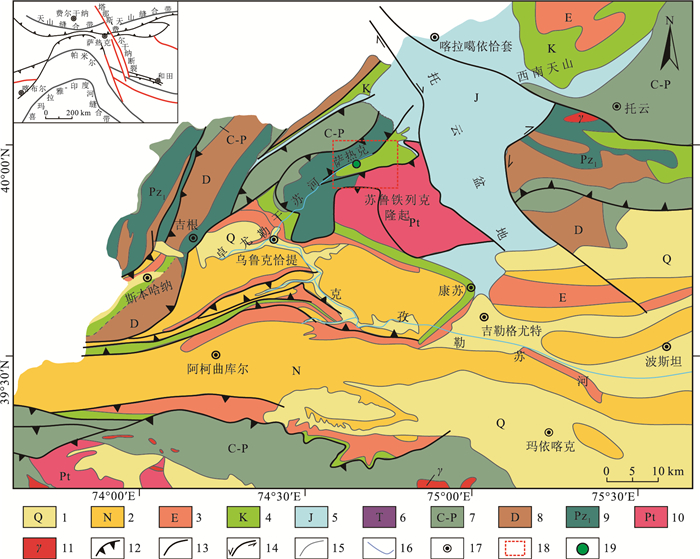
 下载:
下载:
